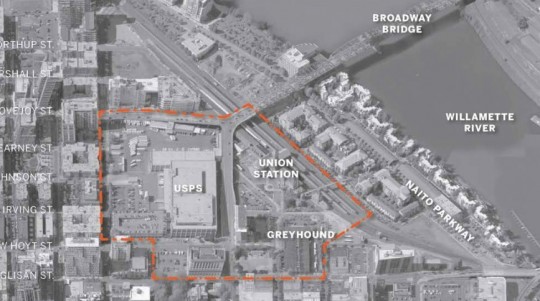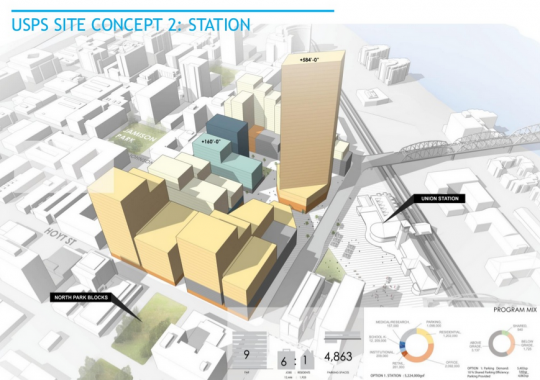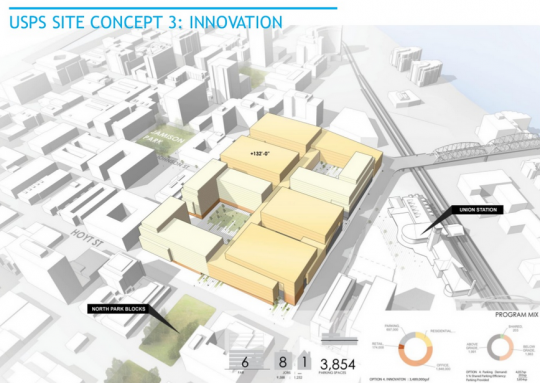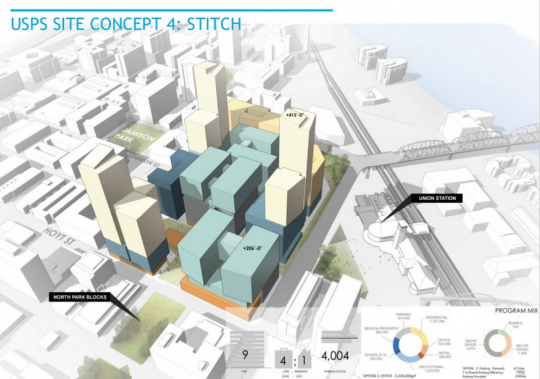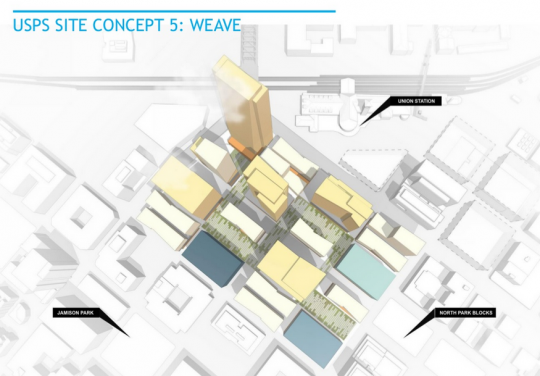As redevelopment proposals for Northwest Portland’s big post office have moved forward, some insiders have been talking about an exciting concept for the site: a flyover ramp that could directly connect the bridge’s 30-foot-high Y-shaped west landing with a new north-south bikeway through the Park Blocks.
Envisioned as a key link in a proposed Green Loop biking path around the central city, a well-designed route through what’s supposed to become a major mixed-use employment and residential development would certainly be costly if it took the form of a floating path — but would also seem likely to become one of Portland’s most iconic pieces of bike infrastructure, reminiscent of Copenhagen’s new Bicycle Snake.
So when the Portland Development Commission last month released five renderings with various possibilities for the Post Office site, it was a minor surprise that none of them explicitly included the possibility.
Here are the five concepts released by the PDC, which is the city government’s in-house economic development agency:
First, the “Cascade” concept, which PDC staff said probably includes the recommendation most similar to a flyover path because it specifies a “central path” for the Green Loop. The design pictured, however, uses a series of weaving staircases to reach ground level north of Hoyt Street.
Here’s the PDC’s “Station” concept, which focuses on creating a new public plaza area in front of Union Station and would jog a central bike route west on Johnson before turning south onto an extended Park Avenue.
Here’s their “Innovation” concept, which PDC staffer Sarah Harpole said is focused on creating a site that could be home to “the Amazon, the Googles of the world.” It imagines a more cohesive, lower-rise set of buildings with a bike route running beneath them on Park Avenue.
Here’s the “Stitch” concept, which sets out to create a continuous, retail-activated 6th Avenue around Union Station that would create a sense of continuity between the Pearl and Old Town in front of Union Station. Unlike the other concepts, this doesn’t envision any descent of bikes from the Y of the bridge, but would instead send bikes west to 9th on the existing Lovejoy viaduct before giving them a chance to turn south.
Finally, there’s the “weave” concept, which creates a more meandering route (and, presumably, the gentlest possible slope) through the site:
Advertisement
Though there’s something to be said for all these possibilities, I wanted to know whether that iconic flyover concept was out of the picture.
“We’re kind of at a very early level in our diagrams,” Harpole said. She says these plans shouldn’t be considered as distinct alternatives, but rather collections of concepts that could be mixed, matched and edited. The PDC wants to hear, for example, how worried people are about weaving and how worried they are about the slope, and which sorts of grid connections people would find most useful.
“It was just meant to be provocative, part of a conversation,” she said. “As we start to take these five concepts and boil them down into more refined, into a single concept, we’re able to take that feedback.”
As for the pathway, Harpole referred me to Nolan Lienhart of Zimmer Gunsul Frasca, the Portland-based architecture firm that’s managing the site design and planning process.
“I don’t think it’s out of the picture yet; I wouldn’t even say that anyone has even started trying to push it out of the picture,” said Lienhart, who is enthusiastic about the concept of a “floating, flying pathway.” “There’s a number of different ways it could happen.”

Green Loop bike route, associated
with the “Cascade” concept.
The key constraints, Lienhart said, are the cost and the slope of the path, which would need to be 600 feet long or more in order to achieve the 5 percent slope required by the Americans with Disabilities Act.
“Typically conservative engineers will have you design at 4.75 to be safe,” Lienhart said.
The distance from the center of the Broadway Bridge’s “Y” to Hoyt Street is about 900 feet, so there’s not much space to spare, but Lienhart thinks it’s possible if the full length of the site were to be used.
In any case, Harpole said, the various possibilities for getting people from the Broadway Bridge to the Park Blocks on bikes should be seen as a route that would add to the options for people biking rather than replacing the existing (though definitely imperfect) descent on Broadway toward the heart of downtown.
“I think you always assume Broadway is an active bike corridor,” she said.
Harpole urged people interested in the proposals to submit feedback to the PDC using its online Town Hall.
“We’re at the design idea phase, so what we want to do is just hear from folks,” she said. “The more perspectives we get, the better.”


